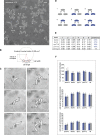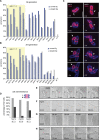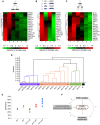Dynamics of cell shape inheritance in fission yeast
- PMID: 25210736
- PMCID: PMC4161360
- DOI: 10.1371/journal.pone.0106959
Dynamics of cell shape inheritance in fission yeast
Abstract
Every cell has a characteristic shape key to its fate and function. That shape is not only the product of genetic design and of the physical and biochemical environment, but it is also subject to inheritance. However, the nature and contribution of cell shape inheritance to morphogenetic control is mostly ignored. Here, we investigate morphogenetic inheritance in the cylindrically-shaped fission yeast Schizosaccharomyces pombe. Focusing on sixteen different 'curved' mutants--a class of mutants which often fail to grow axially straight--we quantitatively characterize their dynamics of cell shape inheritance throughout generations. We show that mutants of similar machineries display similar dynamics of cell shape inheritance, and exploit this feature to show that persistent axial cell growth in S. pombe is secured by multiple, separable molecular pathways. Finally, we find that one of those pathways corresponds to the swc2-swr1-vps71 SWR1/SRCAP chromatin remodelling complex, which acts additively to the known mal3-tip1-mto1-mto2 microtubule and tea1-tea2-tea4-pom1 polarity machineries.
Conflict of interest statement
Figures



References
-
- Martin SG, Chang F (2005) New end take off: regulating cell polarity during the fission yeast cell cycle. Cell Cycle 4: 1046–1049. - PubMed
Publication types
MeSH terms
Grants and funding
LinkOut - more resources
Full Text Sources
Other Literature Sources
Molecular Biology Databases

